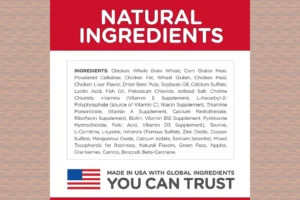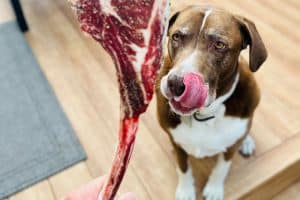Choosing the right dog food can often feel like solving a Rubik’s Cube blindfolded. You’re not alone if you’ve ever found yourself squinting at tiny texts and confusing terms on a dog food label, wondering if you’re making the right choice for your furry best friend.
By the end of this post, you’ll have a go-to guide for demystifying dog food labels, ensuring your pup gets the nutrition they deserve.
Key takeaways:
- Look for named meat as the first ingredient for a protein-packed meal without fillers.
- Understand “Complete and balanced” means it can be the sole diet, tailored for specific life stages.
- Check for “chelated minerals” and avoid foods with ambiguous ingredient terms like “meat flavor”.
What’s in a Name? Understanding Dog Food Branding
When you’re strolling down the pet food aisle, the array of choices can be frankly overwhelming. But let’s zero in on one of the first things you see: the product name. Ever wondered what “Chicken Dinner” or “Beef Flavor” actually means for the meat content of your dog’s dinner? It’s not just fancy wording; these terms are regulated to give you insights into what you’re really feeding your furry friend.
- “Chicken Dinner” or “Beef Entrée” suggests that at least 25% of the product is made up of the named ingredient. However, this percentage includes the water content, which is typically high in wet foods. So, the actual meat content is less than what you might initially think.
- Products labeled as “with chicken” or “with beef” only need to contain a minimum of 3% of the named meat. Yes, just 3%! That’s a minuscule amount that’s more about flavor than nutrition.
- And then there’s the “chicken flavor” or “beef flavor.” This means that there’s enough of the chicken or beef (or their by-products) to be detectable, but the actual percentage can be very low—enough to taste, not enough to count as a significant dietary contribution.
Stickler’s tip: If you want to make sure your dog is getting a meat-packed meal, look for products where the meat (e.g., “Chicken” or “Beef”) is the first word in the name without any qualifiers. It’s a subtle difference in wording but a big difference in quality.
Deciphering the Ingredients List
The ingredients list on dog food packaging is the roadmap to understanding what you’re feeding your dog. Here’s the golden rule: ingredients are listed by weight, starting with the heaviest. But there’s a catch – this weight includes moisture, which is most significant in fresh or frozen ingredients. So, while fresh chicken might top the list, its weight is less impressive once you remove the water content.
Key Takeaways:
- The first five ingredients are crucial because they make up the majority of the diet. High-quality dog foods typically have one or more specified animal proteins (like “chicken” or “beef,” not just “meat”) in the top spots.
- Whole vegetables, fruits, and grains are beneficial, but their placement on the list is essential. They should complement the animal proteins, not overshadow them.
- Beware of splitting: Manufacturers might divide similar ingredients into smaller categories (e.g., “ground corn,” “corn gluten,” and “corn bran”) to lower them on the list. This trick makes the meat content appear more dominant than it actually is.
Pro tip: Look for the term “chelated minerals.” This indicates minerals that are easily absorbed by your dog’s body. It’s a sign of a high-quality dog food that goes above and beyond for your pet’s health.
The Nutritional Adequacy Statement
This part of the label is a goldmine of information. The Nutritional Adequacy Statement tells you if the dog food can be your pet’s sole diet. More than just a stamp of approval, it indicates whether the food is formulated for a specific life stage (puppy, adult, senior) or if it’s designed for all life stages. Here’s where you find out if the food meets the standards set by the Association of American Feed Control Officials (AAFCO).
Decoding the Statement:
- “Complete and balanced” means the food provides all the necessary nutrients in the right ratios for your dog. This is what you want for an everyday diet.
- Pay attention to life stage recommendations. Puppies and seniors have different nutritional needs than adult dogs. A formula tailored for your dog’s current life stage is essential for optimal health.
- Unique insight: If you see “tested in feeding trials,” it means the company has gone the extra mile to ensure dogs thrive on this diet, beyond just meeting the basic AAFCO standards.
Not the end of the story: Remember, understanding dog food labels is your first step in ensuring your pet enjoys a nutritious diet. But it doesn’t stop here. Stay tuned as we dive deeper into choosing the best food for your dog’s unique needs, including those with special dietary requirements and health conditions.
Decoding the Guaranteed Analysis
Ever find yourself squinting at the back of your dog’s food package, trying to make sense of the “Guaranteed Analysis”? You’re not alone. This section of the label is like a nutritional promise from the manufacturer, but decoding it can feel like you’re cracking a secret code. Let’s break it down into something a bit more digestible.
What’s in the Numbers?
-
Protein : This is the powerhouse nutrient for your dog, crucial for muscle repair and growth. A high percentage is often seen as a mark of quality, but the source is just as important. Look for named meat sources like “chicken” or “beef” rather than vague terms like “animal protein.”
-
Fat : Dogs need fat for energy and healthy skin and coats. However, too much fat can lead to obesity, especially in less active dogs. A balance is key, and again, the source matters – look for fats from named animals or plants.
-
Fiber : This is vital for a healthy digestive system. While dogs don’t need as much fiber as humans, a good amount can help with regular bowel movements and even aid in managing weight.
-
Moisture : Wet foods naturally have a higher moisture content than dry foods. While this might seem less important, hydration is crucial for your dog’s health, especially if they’re not great at drinking water.
A Unique Insight
Here’s something you might not find in every guide: the ratio of these percentages can tell you a lot about the food’s target demographic. For example, a higher protein and fat content with lower fiber might be aimed at very active dogs or those with certain dietary needs. Understanding this can help you choose the best product for your dog’s lifestyle.
Recognizing Food Allergens and Sensitivities
Dogs, much like people, can have allergies and sensitivities to certain ingredients in their diet. Identifying and understanding these potential irritants can make a world of difference in your dog’s well-being. Below, we’ll discuss how to spot common allergens and select a dog food that keeps your furry friend happy and healthy.
Common Culprits
Some of the most frequent offenders include:
- Proteins: Beef, chicken, and dairy are tops on the list. Surprising, right? We often think of these as staple proteins, but they can cause issues for sensitive pups.
- Grains: Wheat and corn are biggies here, often leading to itchy skin and digestive woes.
- Soy: This plant-based protein can be hard for some dogs to digest and is another common allergen.
Tips for Selection
-
Read the Fine Print : Ingredients are listed by weight, so allergens present in large amounts will appear early in the list. If your dog is sensitive to chicken, for instance, and “chicken” is within the first few ingredients, that food might not be the best choice.
-
Know the Lingo : Ingredients may be listed under different names. For example, “poultry meal” can be a sneaky way of incorporating chicken. Familiarize yourself with these terms to avoid unintentionally exposing your dog to allergens.
-
Consider Limited Ingredient Diets (LIDs) : LIDs are designed with fewer ingredients, making it easier to avoid allergens and identify what might be causing reactions.
-
Trial and Error : Sometimes, finding the right food is a process of elimination. Start with foods that avoid known allergens for your pet and observe any changes in their health or behavior.
Going the Extra Mile
Here’s something a tad unconventional but invaluable: if your dog suffers from unexplained allergies or sensitivities despite your best efforts, consider working with a veterinary nutritionist. These experts can help design a diet tailored to your dog’s specific needs, eliminating guesswork and ensuring they get the right balance of nutrients.
Understanding your dog’s food label doesn’t have to feel like decoding an ancient manuscript. With these insights, you’re well on your way to making informed choices about your pet’s diet, ensuring they’re not only satisfied at mealtime but thriving every day.
Alex, a passionate animal lover, has experience in training and understanding animal behavior. As a proud pet parent to two dogs and three cats, he founded AnimalReport.net to share insights from animal experts and expand his knowledge of the animal kingdom.





